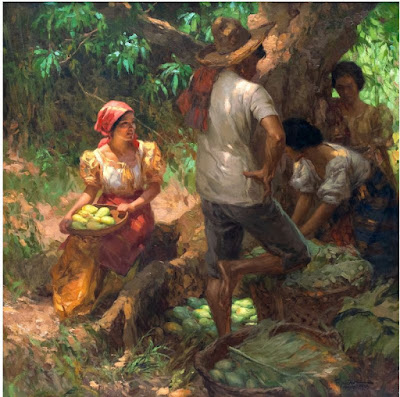Four days after his death, Amorsolo was posthumously honored as the first National Artist of the Philippines at the Cultural Center of the Philippines.

The volume of paintings, sketches, and studies of Amorsolo is believed to have reached more than 10,000 pieces. Amorsolo was an important influence on contemporary Filipino art and artists, even beyond the so-called "Amorsolo school." Amorsolo's influence can be seen in many landscape paintings by Filipino artists, including early landscape paintings by abstract painter Federico Aguilar Alcuaz.

In 2003, Amorsolo's children founded the Fernando C. Amorsolo Art Foundation, which is dedicated to preserving Fernando Amorsolo's legacy, promoting his style and vision, and preserving a national heritage through the conservation and promotion of his works.
During his lifetime, Amorsolo had a total of 14 children from two marriages and a common-law-wife. In 1916, he married Salud Tolentino Jorge, with whom he had six children; Salud died in 1931. He then met and lived with common-law wife, Virginia Guevarra Santos, with whom he had three children, namely Manuel (who followed in his father's footstep, with a degree in Fine Arts from the University of the Philippines), Jorge and Norma before he met his would-be second wife, Maria del Carmen. While they were still together, Virginia found an engagement ring in one of Amorsolo's drawers; she knew the ring was for Maria, that prompted her to leave his house with her three children.
In 1935, Fernando married Maria del Carmen who gave him eight more children. Among her daughters with her are Sylvia Amorsolo-Lazo and Luz. But while they were married and Maria was giving birth to his children, Fernando had three more children with Virginia. His reputation was growing as fast as his brood and his work was more than enough to provide for his rather large family. Six of Amorsolo's children became artists themselves. His descendants include Eula Valdez and Paolo Ballesteros.
For Complete Details read:
https://en.wikipedia.org/wiki/Fernando_Amorsolo
Meanwhile, here's Amorsolo's Painting of the Nipa Hut valued from P750,000 to P850,000. The current dollar to pesos exchange is around 1 to 60. It used to be 1 to 2 when I was a kid, 
Compared this to the Jesse Santos,The Nipa Hut that I owned and displayed in my Apartment Living room here at THD(see painting below).
Since 1998 the record price for this artist at auction was $1,030,104 USD sold at León Gallery, Makati in 2024.
Lastly: Here's the List of 7 Most Expensive Paintings In The World 2023
The most renowned paintings, particularly those hailing from the era before 1803, their custodial domain is chiefly the hallowed halls of museums, beckoning patrons from all corners of the world. These veritable gems, seldom traded or sold, stand as exemplars of artistic excellence, and their worth transcends mere valuation.
1. Mona Lisa - $970 Million
2. Salvator Mundi - $450.3 Million
3. Interchange - $300 Million
4. The Card Players - $250 Million
5. Nafea Faa Ipoipo - $210 Million
6. Number 17A - $200 Million
7. Wasserschlangen II - $183.8 Million
I am familiar with Painting #1 and #2. I need to see the remaining paintings in the list. How about you? Have you seen all of the 7 paintings in the list above? If you have, I salute You!
https://marinduquemyislandparadise.blogspot.com/2025/08/discrimination-in-united-states.html






No comments:
Post a Comment